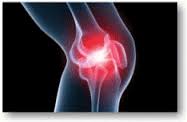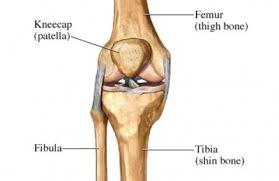The knee is largest joint in the body and is described as a hinge joint. Bending , of the knee occurs through the action of our hamstring muscles. Straightening of the leg is a result action of the thigh muscles or quadriceps. 15% of all sports injuries involve the knee, however half of these will end up visiting a sports doctor. Therefore when the knee is injured it is a very likely to require further treatment.
The knee consists of two joints; the tibiofemoral joint where the thigh bone (femur) connects with the shin bone (tibia and fibula) via a network of ligaments, such as the cruciate and the collateral ligaments. Inside the knee joint we have a layer of cartilage known as the menisci which acts both as a shock absorber and provides a smooth gliding surface for movement in the knee joint. The second such joint is the patellofemoral joint where the kneecap slides over the front of the tibiofemoral joint.
The types of knee injuries vary from sudden acute events to overuse injuries which result from repetitive activities where there is repeated or prolonged stress on the knee. In this article we will deal with the most common conditions seen in our clinic.
Acute knee injuries may be caused by a direct blow to the knee, twisting /turning motion at the knee joint, collisions or landing from a jump. One of the most widely publicised knee injuries, especially among sportspeople is a torn Anterior Cruciate Ligament (ACL) . Knee injuries account for 9% of all hurling and football injuries,1.5% of these injuries are ACL tears. Interestingly females are more likely due damage their knee joint due anatomical and biological differences then their male counterparts. The ACL provides stability to the knee joint by preventing forward movement of the shin bone on the femur and also controls the rotation of the shin bone in relation to the femur. Without an ACL the knee becomes very unstable especially in twisting or cutting movements. In the case of a torn ACL there is often damage to other structure’s within the knee joint such as the meniscus or medial collateral ligaments.
Patellofemoral pain or chondromalacia patellae is an overuse injury of the knee commonly seen in the clinic. Patellofemoral pain is a broad term used to describe pain in and around the knee cap, the cause of which can be due to a number of factors such as lower limb biomechanics, reduced flexibility of soft tissue structures in the lower limb, this combined with repeated or prolonged pressure on the knee results in patellofemoral pain. People often complain of pain when coming down stairs, squatting or jogging.
Osteoarthritis (OA) of the knee joint commonly called wear and tear arthritis occurs when the protective layer of cartilage covering the end of the bones wears down over time. This causes the bones of the joint to rub more closely together, resulting in pain stiffness and swelling, reduced range of motion, formation of bone spurs and crepitus. Risk factors for OA include age, weight, previous injury and muscle weakness.
Bursae are small sacs of fluid that cushion and lubricate soft tissue structures within the knee joint during movement; these can become inflamed from time to time resulting in knee bursitis.
Treatment of a knee injury may include first aid measures such as rest, ice, compression and elevation (RICE). Treatment depends on location, type and severity of injury as well as age, occupation, and activity levels. There are several other conditions of the knee which are not covered by this article however, the conditions presented are the most commonly seen in the clinic on a daily basis.
Noel O’ Connor D.O.

